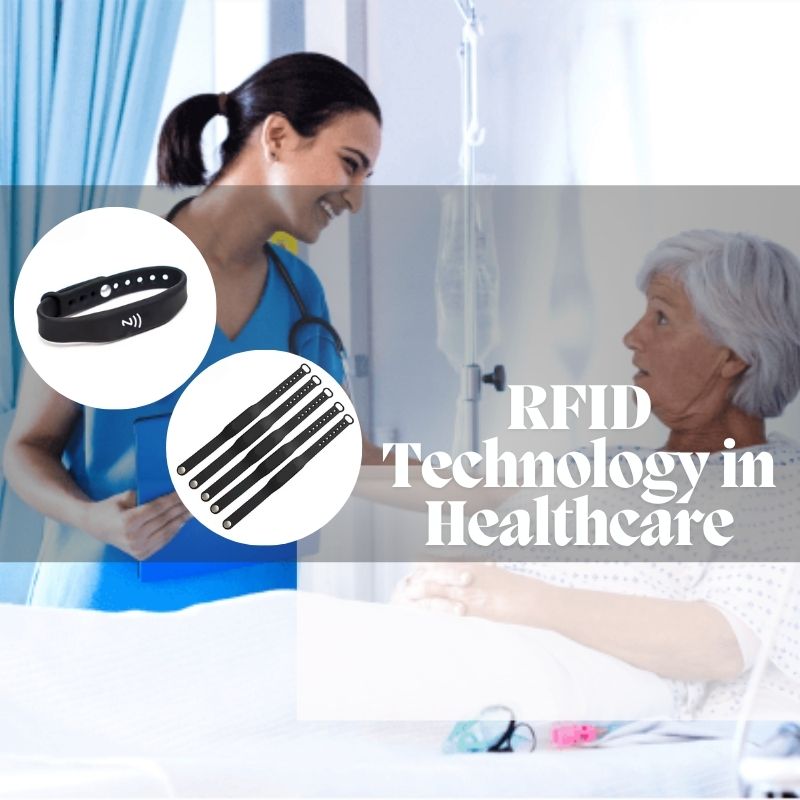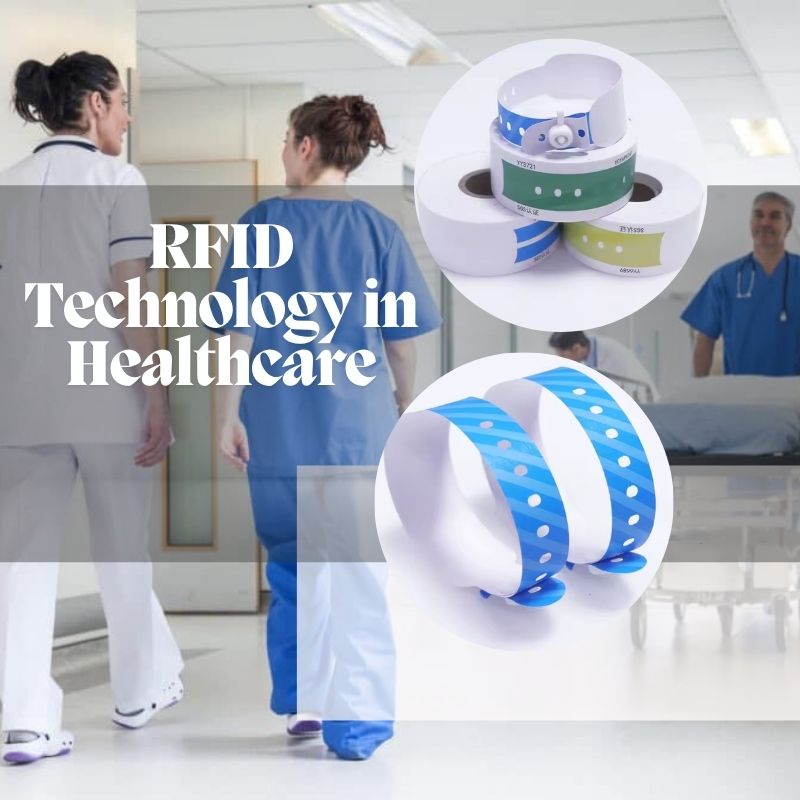
What are the Benefits of RFID Technology in Healthcare?
Table of Contents
RFID Technology in Healthcare: Transforming Patient Care and Safety
This article explores the uses, benefits, and challenges of implementing RFID in healthcare, with a focus on its ability to improve patient care and optimize workflows in hospitals and other healthcare facilities.

What Is RFID Technology and How Does It Work?
RFID technology uses radio waves to transfer data between a tag and a reader, enabling wireless identification and tracking. An RFID system typically consists of:
- RFID Tags: These store data and are attached to objects or equipment.
- RFID Readers: Devices that scan and retrieve information from the tags.
- Antenna: Facilitates communication between tags and readers.
This system operates seamlessly to track assets, streamline operations, and enhance patient care.
How Is RFID Used in Healthcare?
The use of RFID technology in healthcare spans a wide range of applications:
- Patient Tracking: RFID tags attached to wristbands ensure proper identification and location tracking.
- Medication Management: Tags embedded in packaging help monitor inventory and prevent medication errors.
- Equipment Tracking: RFID-enabled tracking ensures the availability of critical medical devices.
What Are the Benefits of RFID Technology in Healthcare?
The adoption of RFID technology in healthcare offers several advantages:
- Enhanced Patient Safety:
- Prevents errors in medication administration and patient identification.
- Operational Efficiency:
- Automates inventory management and streamlines workflows.
- Real-Time Tracking:
- Provides instant visibility into the location of assets and patients.
“RFID technology transforms healthcare facilities by automating processes and improving safety.”
How Does RFID Improve Patient Safety?
Patient safety is a critical concern in healthcare, and RFID technology plays a significant role in reducing risks:
Accurate Patient Identification:
- RFID wristbands ensure that patients receive the correct treatments and medications.
Error Prevention:
- RFID tags help reduce medical errors by providing real-time data on patient care.
What Challenges Are Associated with RFID technology in Healthcare?
Despite its advantages, implementing RFID in healthcare presents challenges:
- High Initial Costs:
- The cost of RFID tags, readers, and infrastructure can be prohibitive.
- Integration Issues:
- Integrating RFID systems with existing health information technology can be complex.
- Privacy Concerns:
- Patient data must be protected to comply with regulations.
Applications of RFID in Hospitals
Hospitals are the primary beneficiaries of RFID technology in healthcare:
Operating Room Efficiency:
- Tracks the availability and usage of surgical tools.
Inventory Management:
- Ensures timely replenishment of medical supplies.
Patient Flow Management:
- Optimizes scheduling and reduces wait times.
“RFID in hospitals ensures smoother operations and improved patient experiences.”
How Does RFID Enhance Asset Management?
Managing medical equipment is a significant challenge for healthcare providers. RFID simplifies this process:
Asset Tracking:
- Monitors the location and usage of devices like ventilators and infusion pumps.
Maintenance Scheduling:
- Ensures timely servicing of equipment to avoid downtime.
The Role of Passive and Active RFID Tags in Healthcare
Both passive RFID tags and active RFID tags play vital roles in healthcare:
Passive RFID Tags:
- Power Source: Draw energy from the reader.
- Use Cases: Patient wristbands, medication packaging.
Active RFID Tags:
- Power Source: Contains an internal battery.
- Use Cases: Tracking high-value equipment and monitoring real-time location.
“Choosing between active and passive RFID tags depends on the application requirements.”

Pros and Cons of RFID Technology in Healthcare
Pros:
- Enhances patient care and safety.
- Reduces operational costs and improves efficiency.
- Provides real-time tracking and inventory visibility.
Cons:
- High setup and maintenance costs.
- Integration challenges with legacy systems.
- Potential data privacy concerns.
The Future of RFID Technology in Healthcare
The future of RFID in healthcare is promising, with emerging trends such as:
- IoT Integration:
- Connecting RFID systems with IoT devices for advanced monitoring.
- AI-Powered Insights:
- Leveraging RFID data for predictive analytics in patient care.
- Sustainable Solutions:
- Developing biodegradable and eco-friendly RFID tags.
FAQs About RFID Technology in Healthcare
How does RFID improve patient care?
RFID ensures accurate patient identification, reduces errors, and streamlines workflows, enhancing overall care quality.
What are the main applications of RFID in hospitals?
Applications include patient tracking, medication management, and equipment monitoring.
What are the challenges of implementing RFID in healthcare?
Challenges include high initial costs, integration complexities, and data privacy concerns.
How does RFID benefit asset management in healthcare?
RFID enables real-time tracking, maintenance scheduling, and efficient inventory management.
What is the difference between active and passive RFID tags?
Active tags use internal batteries for extended range, while passive tags rely on the reader’s energy.
Comments
Hot Products

What Is RFID Waste Management
Imagine a city where every trash bin speaks — not literally — but through a tiny chip that tells the system when it’s full, when it’s emptied, and where it went. That’s what RFID waste management is doing today.

What are Bolt Seals and their Applications? | Complete Guide
In global trade and logistics, bolt seals play a crucial role in ensuring cargo security and compliance. These small but powerful devices are designed to lock shipping containers, trailers, and cargo doors with a tamper-evident mechanism.

What is an RFID Card Protector? Benefits, Use Cases, and Buying Guide
RFID technology (Radio Frequency Identification) is everywhere: in your credit cards, ID badges, transit passes, hotel room keys, and more. It offers speed and convenience, but it also opens the door to a new kind of digital theft called “skimming.” That’s where an RFID card protector comes in.

RFID Wristbands for Events: Bulk Buying Guide for Organizers
RFID wristbands for events are becoming the go-to solution for organizers who need faster entry, fraud prevention, and cashless payments at concerts, festivals, and sports venues. Unlike paper tickets or QR codes, these smart wristbands use embedded chips to streamline access, secure transactions, and improve the guest experience.

How RFID Tag on Windscreen Improves Vehicle Access Control and Toll Systems
In today’s fast-paced world, vehicle identification needs to be quick, secure, and contactless. An RFID Tag on the Windscreen provides exactly that — a reliable way to manage toll collection, parking, and gated access without stopping vehicles.

The Benefits of RFID Linen Tags in Commercial Laundry
Managing laundry in hospitals, hotels, or large laundry services is a big job. Each day, thousands of sheets, towels, and uniforms are washed, sorted, and sent back out. But problems like lost linens, sorting mistakes, and manual counting can cost companies a lot of money. For example, mid-sized hotels can lose over $200,000 each year from missing linens.
That’s where RFID Linen Tags come in.
Tags
RELATED BLOGS

What Is RFID Waste Management
Imagine a city where every trash bin speaks — not literally — but through a tiny chip that tells the system when it’s full, when it’s emptied, and where it went. That’s what RFID waste management is doing today.

What are Bolt Seals and their Applications? | Complete Guide
In global trade and logistics, bolt seals play a crucial role in ensuring cargo security and compliance. These small but powerful devices are designed to lock shipping containers, trailers, and cargo doors with a tamper-evident mechanism.

What is an RFID Card Protector? Benefits, Use Cases, and Buying Guide
RFID technology (Radio Frequency Identification) is everywhere: in your credit cards, ID badges, transit passes, hotel room keys, and more. It offers speed and convenience, but it also opens the door to a new kind of digital theft called “skimming.” That’s where an RFID card protector comes in.




